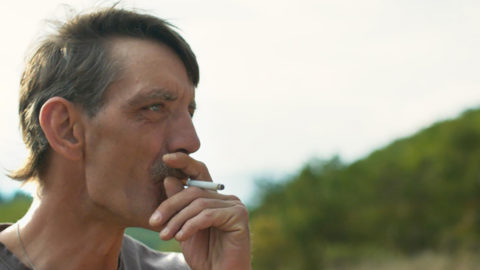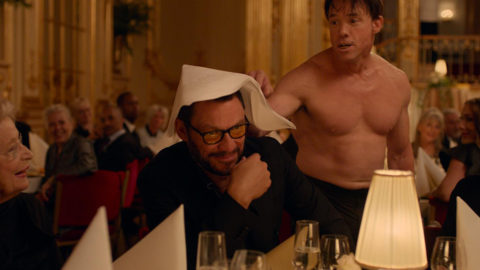Interview: Thomas Arslan
A highlight of the 2017 Berlin International Film Festival, Thomas Arslan’s new feature Bright Nights continues to push a filmmaker known for his tightly wound urban genre exercises into territory that seems intent on inverting the spatial and psychological coordinates of his characters and their circumstances as much as it does the particulars of his own process. The German director and Berlin School veteran’s follow-up to his provocatively impressionistic western Gold (2013), Bright Nights traffics less in genre than archetypes: Centered on middle-aged divorcee Michael (Georg Friedrich, winner of a Silver Bear for Best Actor), who in the wake of his father’s death attempts to reconnect with his estranged teenage son Luis (Tristan Göbel), the film doesn’t deign to venture far from familiar familial strictures. Rather, Arslan attempts to chart his characters’ psychological tensions through a visual and rhythmic symbiosis with his chosen environment; on the road to tend to their late elder’s estate in a remote town in northern Norway, Michael and Luis find their relationship to be as strained and distended as the breathtaking landscape is harmonious and effortlessly expansive. Swelling with unarticulated anguish and surreal narrative strokes—Arslan, as provocatively as any of his contemporaries, continues to utilize imagery and atmosphere as reflexive outlets for the tensions inherent in his storytelling—Bright Nights serenely navigates complicated emotional terrain with a modest arsenal of stylistic gestures and a wealth of thematic insight.
Arslan sat down with Film Comment following the premiere of Bright Nights at the 67th Berlinale to discuss his incremental move away from genre cinema, the role of remote landscapes in his recent work, and the serendipitous moments that lend his latest film its unique aura.
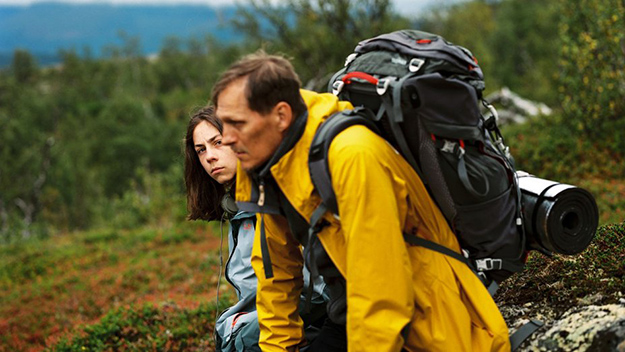
You’re known for your bold takes on genre films. Bright Nights isn’t a genre film per se, but it does deal with a familiar story of a divorced father attempting to reconnect with his son. I’m curious what tends to come first for you: the characters, or the type of film you’d like to make?
I’m not sure why, but normally I start with places, not from a story and not from characters. Sometimes these are places I’ve discovered on my own, and some of them I’ve seen first in pictures. These places are kind of like playgrounds, or possible playgrounds. This is very often the starting point for me, how these places inspire me to somehow develop something cinematically. And it was the same with Bright Nights. I had been to this area of Norway several times before, and it gave me the inspiration to set a story there. So that was the first step. The second step, coming after my last film [Gold] where I was already trying to do something different, trying not to be too conceptual after doing a few genre films—to again do something as an answer to the last film. In logistical terms Gold was very complicated: a tight schedule, where we were unable to do many variations [on scenes], while having to handle like fourteen horses and a chuck wagon and things like this. It gave me a feeling afterward of very unfree shooting. So I wanted to have a setting this time where I was more free, to change or develop things during the shooting.
You shot the film in northern Norway, with your previous collaborator, cinematographer Reinhold Vorschneider. Can you talk a bit about the landscapes in the film, and how your chose to depict this environment?
We made several research trips [to Norway], after which we decided to shoot in this specific area. It was an interesting choice because, for one, it’s not actually very far from here [Berlin], but on the other hand it’s very remote, which was important for the story as well because these two characters are really stuck together, and can’t remove themselves from one another, and thus have to really get along despite all their failures over these few days in the film. So we looked for this kind of area, with this kind of landscape, and tried to find a balance, avoiding postcard-like images on the one hand, but on the other trying not to hide the natural beauty of the environment as well. It was important to give this area a presence in the film. So it was a point of concern: how to film the locations and which places to feature.
Have you found it different or more challenging shooting in these far-flung locations compared to your city-set films?
Yes, but mostly just different. The preparation is different—it’s a different kind of exploring. The main thing for me, compared to my films that have been set mostly in Berlin—which is a city I know very well—is that these last two films have featured landscapes that I’m not very familiar with. And this led to logistical concerns as well: for example, we had to find a base where the crew could stay for an extended period of time, without moving to a new place every day. We were exploring a foreign area, which led to its own unique challenges.
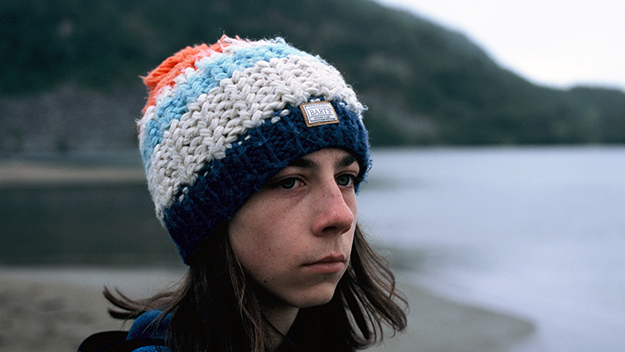
With a story this intimate and filled with small character details, it’s hard to conceive of the film as not being at least partially autobiographical. Does it in fact relate to your experiences at all?
It’s not straight autobiography, but there are a lot of personal elements in the film. It’s more a mixture, or a montage of personal details and things I discovered in these new surroundings. And of course things that developed naturally in the writing process.
This is your first time working with Georg Friedrich and Tristan Göbel. I imagine finding actors that can develop good chemistry while their characters’ personalities remain mostly at odds must have been difficult.
Yes, this was a topic that was discussed and considered as we developed the film. At first it was obviously just finding the right actors for the characters, but then also having them somehow fit as a couple as well, as a father and a son. I found it more interesting, even though they’re supposed to be father and son, to find two actors that didn’t really resemble one another. The characters are very different people. For me this was an image of their estrangement as well. But initially I simply liked them both as actors. I had seen Tristan in one of the first films he was cast in—and he was the best. He’s very open in front of the camera. And Georg is a very experienced actor of course. I had seen him in many films. I had actually been wanting to work with him for a long time, but because of schedules and things like that, it didn’t happen. This seemed like a good time for me to bring these two together.
There are a few instances in the film where the narrative stops for a moment and proceeds in a slightly surreal direction. I’m thinking specifically of the image of the burning house by the roadside and the lengthy traveling shot up the mountain road and into the fog. How did these sequences come to you?
During our research trip we actually found a bunch of burned houses. Turns out, in this area it’s very common to burn a house down rather than tear it down—it’s just much easier that way, and it allows you to rebuild in the same area. But we actually had to build the house you see in the film. We couldn’t find an appropriate one that for our purposes was close enough to street. So this sequence was preplanned. But for the car scene up the mountain and into the fog, we had shot the scene once before in bright sunlight. But a few days later we saw the same spot covered with fog, which was much more intense and much more interesting visually. So we shot it again.
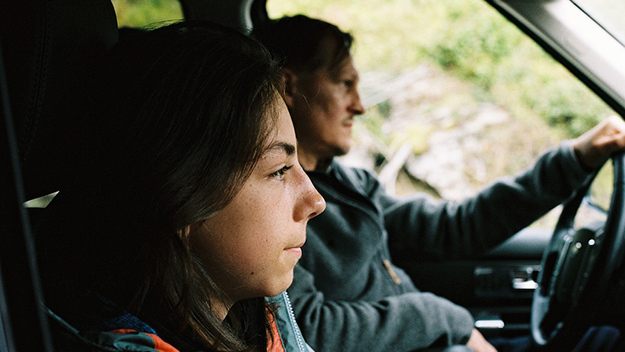
The film is fairly episodic over all. How did the overall shape of the film develop? Where there many sequences or moments you had to get rid of to get to the point where it’s at now?
The chronological order of the film had been set beforehand, in the script. But we shot a lot more scenes along the way and decided to cut many of them out during the editing process, as they didn’t ultimately fit my intentions.
The scene with the young girl, the metal fan, is quite humorous. I hear you’re a big black metal fan?
Well, not only black metal. But you’re right, I do listen to a lot of metal.
Was that one of the inspirations to shoot in Norway?
Not really, but I know a lot of these bands originated in Norway. The music wasn’t one of the initial inspirations to explore the area. There were other reasons at first, but [it ended up working for this scene].
Your films seem to be becoming increasingly minimal, in the best sense. Are you conscious of this development, and are you wary of over-explaining or over dramatizing?
Yes, particularly in the last aspect you mentioned. I’m not trying to be minimalistic as a concept. And I don’t see it that way necessarily. This is just my approach to these kinds of stories. It’s interesting for me to find a form that’s not overdramatized, where you don’t have to provide too much information. I prefer stories where you have to add something of yourself as a viewer. I’m trying to find a form that balances these interests.
Jordan Cronk is a critic and programmer based in Los Angeles. He runs Acropolis Cinema, a screening series for experimental and undistributed films, and is co-director of the Locarno in Los Angeles film festival.



